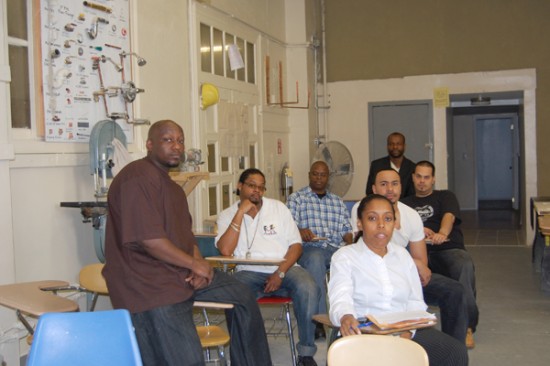
College for construction crew teaches green building
A brand-new duplex apartment in the University Heights section of the Bronx is ready for inspection. Equipped with bamboo floors, a ceramic kitchen and a spacious bedroom closet that would make more than one New Yorker jealous, it would rent for at least $2,000.
Instead it will be demolished. And the construction workers who built the apartment won’t mind seeing it go.
Rogelio Perez, 23, and Josimar Paredes, 21, were on the crew that built the duplex. They started last November by tearing down the work of an earlier crew, while trying to preserve and reuse or recycle as much of the building material as they could.
This process of building and demolition is the way would-be construction workers learn their trade from Project H.I.R.E., a 20-week free training program that offers lessons in the most up-to-date ways to be environmentally sound.
The duplex is in a warehouse-sized classroom at Bronx Community College, where Project H.I.R.E. teaches low-income students 18- to 60-years-old plumbing, carpentry, electrical wiring, painting and tiling, among other skills necessary to find work in the construction industry.
The program is one of the recipients of the $4 million federal stimulus grant to Bronx non-profits that will be distributed by the Consortium for Worker Education.
The grant comes just in time. The program has been operating with funds from the New Yankee Stadium Community Benefits Fund to which the baseball team donated $800,000 to quiet opposition to constructing the new ballpark on public land. That money is almost gone.
Project H.I.R.E. program director Glenda Self hopes the new money, still tied up by federal red tape, will be available in time to start a new class in June.
Project H.I.R.E. is the only program of its kind in the city, according to Self. For the past 25 years, it has taught students to build by doing. They read blueprints, frame the walls, install the wires and pipes and sheetrock the walls and the ceiling. Getting the ceilings up is “the hardest thing to do,” said Perez.
The results of the students’ efforts are three real apartments. Each has doors, stairs, floors, ceilings, windows, kitchens, bathrooms, lights, running water and all the other things a tenant would need.
Two apartments are situated in one end of the room and the duplex in the other. In the middle, between the three units, desks, chairs and a blackboard hanging on a wall form a rough version of a classroom.
“For two weeks they made us watch videos about constructions and read books. After that we begin to pull the apartments down,” said Owen Philips, 22, who moved from Jamaica to New York to gain a better education.
The experience was tough but rewarding. “It was intense. Five months here, working every day,” said Perez who, like 90 percent of the students at Project H.I.R.E., lives in the Bronx.
“Everything is done by the teams; none of this was done by the teachers,” Self added.
Project H.I.R.E. teaches long-standing techniques for saving energy and resources. The students use energy efficient bulbs, for example, and install engineered flooring made of plywood topped with a thin layer of hardwood. “It keeps us from having to cut down so many trees,” explained Self.
The students also learn how to paint, a process that, according to Self, is not as easy as it looks. There’s even an environmentally correct way to choose colors.
“The way you use paint can either cause you to use more energy because it’s too dark in the room or it can help you to reduce your energy use because you used the right colors,” Self explained.
When they begin the course, most of the students have given little thought to the environmental impact of their work. But as the program goes on, teachers notice a change.
“They go home and they try these bulbs and they find out that they would pay less,” said the program head teacher Robert Edwards.
Philips said that he learned to work materials that are more environmentally friendly than what he used in his home country. “In Jamaica we used plastic to do the plumbing and here we use metal,” he said.
Perez, Paredes and Philips are looking for work. Project H.I.R.E. helps them by letting them know of job offers and preparing them for interviews. The students are anxious to find work. “The whole idea is to earn more money,” said Perez who used to work as a porter at the Mets Stadiums.
But money is not the only reward.
Amaris Rodriguez, 31, one of three women who graduated from the last class, just finished building her mother a kitchen. “Anyone would charge her around $10,000, and I did it for free,” she said.
Rodriguez used to work in real estate. She took the course to learn the basics about construction, because her goal is to become a developer, starting her own company. To accomplish that she feels she needs to have construction skills.
A couple of months ago she didn’t know a thing about building, now she is able to built a kitchen with her own hands. “I take it as a life changing experience,” Rodriguez said.

[…] Mott Haven Herald, which features a special report titled, Green Jobs, Green City, with stories by Carla Candia, Alex Green IV, Nick Loomis and Vishal Persaud. Meanwhile, Emily Lavin reported on a trip local […]